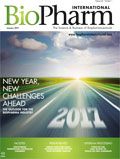Best Practices for Selecting and Using Temperature Sensors in Cold and Cryogenic Storage
A Q&A with PCI Pharma Services about best practices for choosing and maintaining temperature sensors in cold and cryogenic storage.
PCI Pharma Services extended its cryogenic liquid nitrogen (LN2) storage capabilities at its Rockford, Illinois location in November 2016. BioPharm International spoke with Russ Stevens, director of Facilities Engineering at PCI, who was the lead engineer and principal architect for the project, about best practices for selecting and maintaining temperature sensors for cold storage.
BioPharm: What are some considerations for selecting temperature sensors?
Stevens (PCI): For cryogenic measurements, it is crucial to verify that the wire insulation can withstand the temperature as much as the sensor. The ability to interface with the building management system and have a broad sensor selection of resistive values for different scaling of a variety of temperature ranges is important. Each temperature range has different requirements due to the conditions brought on by those set points, particularly for extreme temperatures.
BioPharm: What are some of the challenges you find with temperature sensors in cold storage, and in cryogenic storage in particular?
Stevens (PCI): Typically, the biggest challenges we see in cold storage is determining the right quantity of sensors and, through mapping, establishing their placement. The mapping process will establish the warmest and coldest locations within the cooler or freezer. Once the sensors are placed, systems often need to be tuned to maintain the temperature within alarm ranges of these two areas. For cryogenic storage, the process relies on the physical trait of liquid nitrogen (LN2). As long as the LN2 is maintained at a designed level, the temperature is very stable. The biggest challenge is selecting the proper RTD sensor and transmitter for that low temperature range and make certain that both the sensor and wire are designed to exist in that harsh environment.
BioPharm: What are some best practices for maintaining sensors?
Stevens (PCI): Both temperature and humidity sensors are checked for accuracy using a calibrated standard device. This process may consist of a one-point or three-point calibration. Once completed, any offsets that were applied to a sensor are recorded to establish a baseline. The sensors are then placed into a scheduled program where they are routinely checked for accuracy using the same calibrated standard. If the comparison between the standard and the sensor are within a defined range, the sensor is passed and checked on the next scheduled event. If the device is within the range, but has drifted by a certain percentage, the offset is changed to tighten the reading closer to that which was read on the standard. The offset change is noted and the sensor monitoring is increased in frequency for a given period of time to verify the sensor is stable. If the sensor is found to be out of the acceptable range when compared to the calibration standard, an investigation is started to find a root cause if possible. The baseline offset for the device is verified and electrical connections checked to verify the sensor has in fact failed. Should a sensor be found in a state where it is not stable or has exceeded the expectable calibration range, it is removed from service and replaced with a new device.
Article DetailsBioPharm International
Vol. 30, No. 1
Pages: 53
Citation:
When referring to this article, please cite it as J. Markarian, "Best Practices for Selecting and Using Temperature Sensors in Cold and Cryogenic Storage," BioPharm International 30 (1) 2017.

Thermo Fisher Opens Advanced Therapies Collaboration Center in California
April 18th 2025The 6000-square-foot facility will provide cell therapy developers the support they need to transition to CGMP manufacturing, and an expanded footprint of the new center is expected to open in Philadelphia later in 2025.